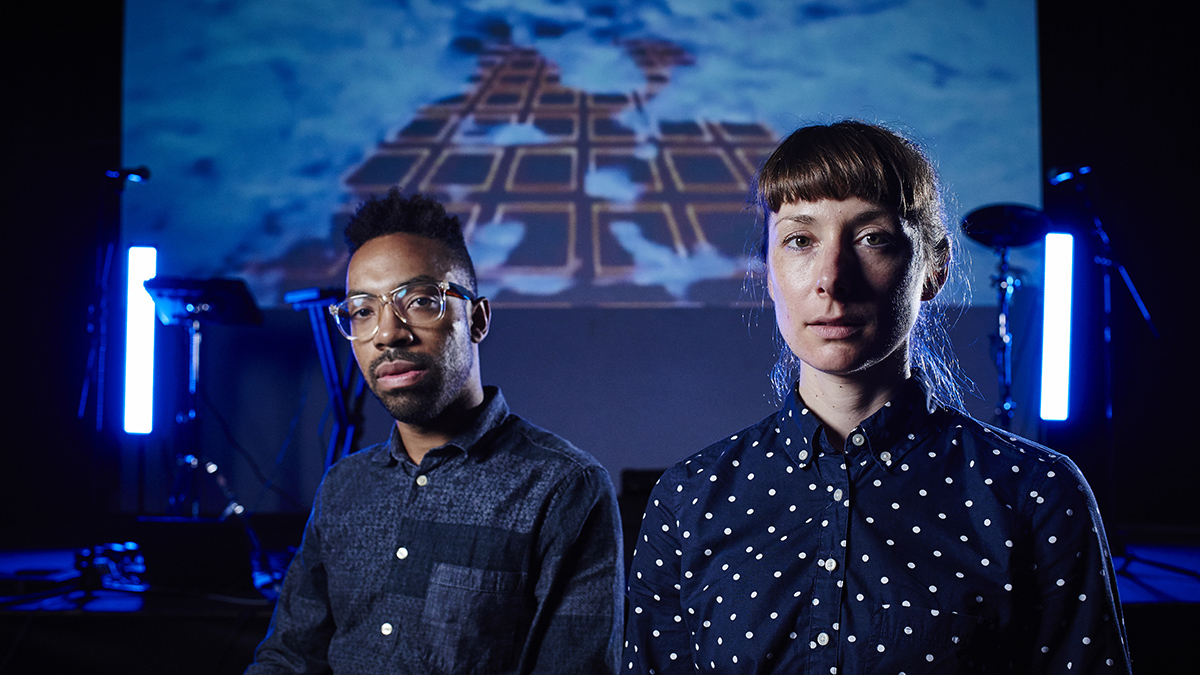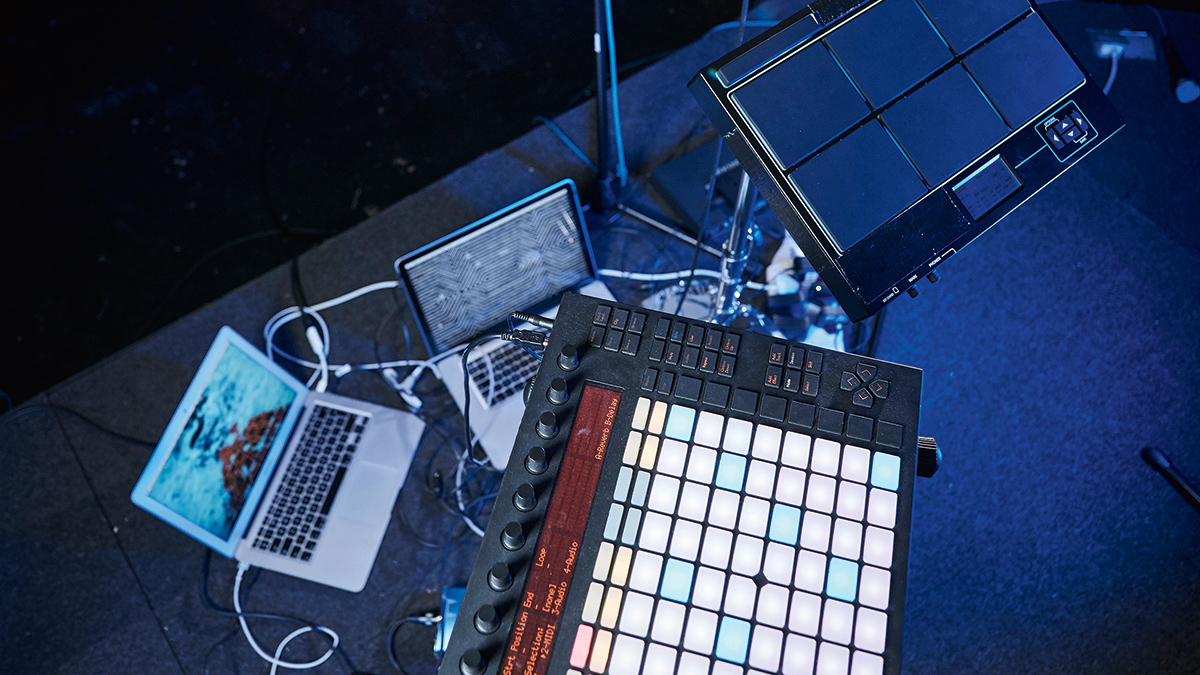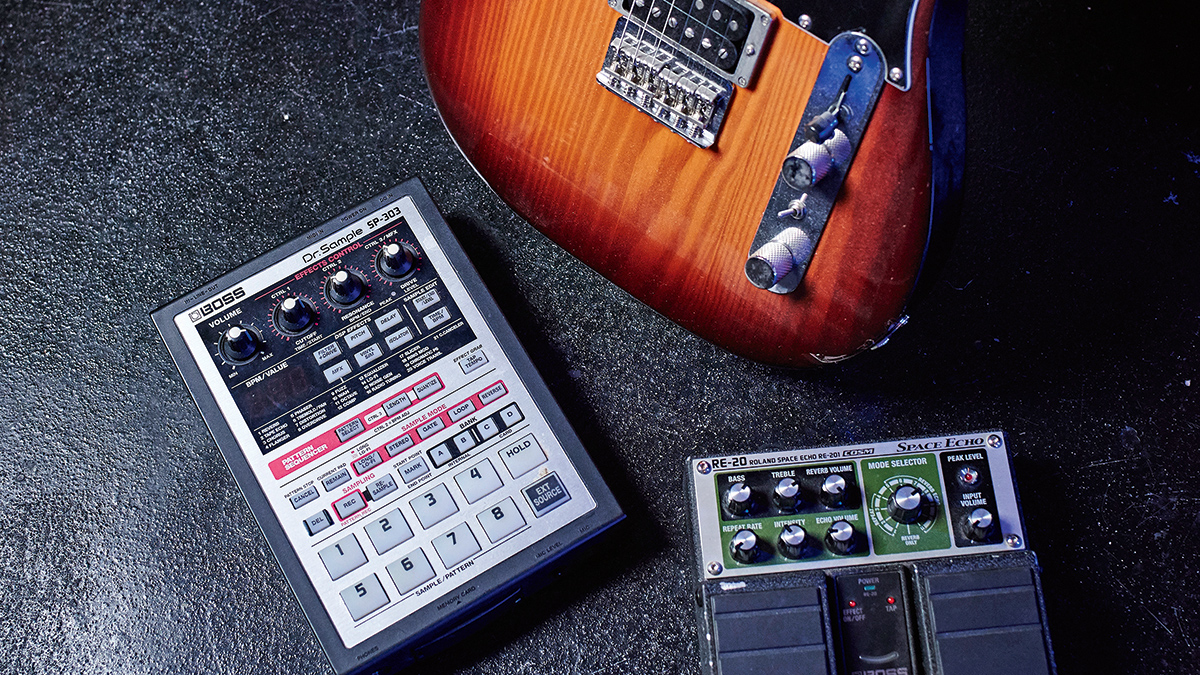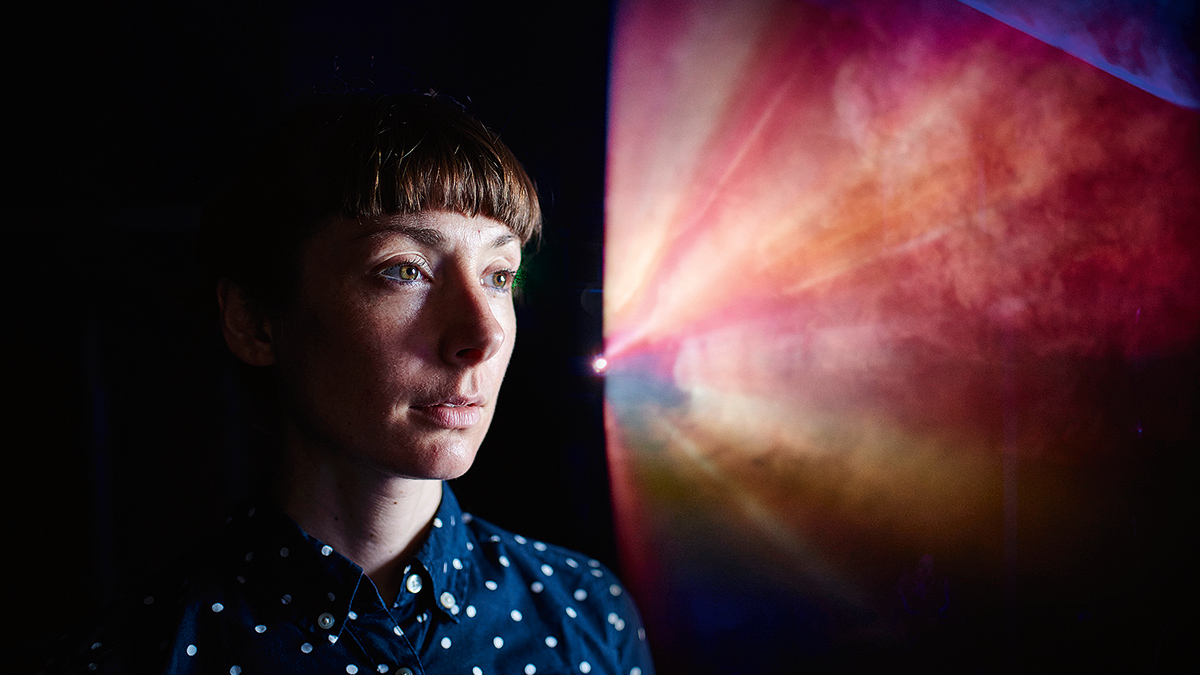Patten on their influences and the concept behind the latest album, Psi
Experimental duo on creating their own frontiers through the use of abstract, sample-based soundscapes.

Following the release of two limited CDRs, patten first came to attention in 2011 with GLAQJO XACSSCO - a fittingly obscure title for an album forged from a combination of chaotic, industrial-sounding rhythms.
Warp Records seemed a natural fit. Known simply as ‘D’ and ‘A’, the duo’s desire for anonymity is intended to encourage their audience to ignore them and focus on every part of each project’s umbrella arc, if not actually become it.
Based on the Greek letter Ψ (Psi), patten’s third album continues their malleable approach to live and studio-based work, which seemingly has no fixed point. Instead, patten exist in a constant state of flux, where relentless experimentation allows them to constantly reinvent their sound.
So patten have now expanded from one member to two, right?
A: “It’s always been a kind of group situation. The project has been running in different ways for almost ten years now and has always evolved. We’ve worked with a lot of different people; not only on this album but on the previous album we worked a lot with the designer Jane Eastlight."
How do you feel you’ve developed as producers across the three albums?
D: “We wouldn’t necessarily see it as a linear progression. From record to record, we’re interested in trying out different ideas and approaches and these are always informed by where we’ve been in the past and are pushing ourselves in the future.
Want all the hottest music and gear news, reviews, deals, features and more, direct to your inbox? Sign up here.
“We see all of the records as having their own aims and intentions and feel like we’ve done quite a good job in fulfilling those, even going back to the release of the CDRs and mixes we’ve done.
“As we go, the parameters shift and what we’re actually trying to do is quite malleable, so in that way it’s definitely always shifting and reaching out. Experimentation is a really central part of what we do.”
We definitely embrace the possibility of the unexpected in what we do and try and create situations where we might bump into things we weren’t expecting.
The 2014 EP Re-edits claimed to produce an endlessly generative mix when played on shuffle? Could you go into that?
D: “Re-edits was a series of EPs we put out across 2014. We recently did a new set of re-edits that worked in a slightly different way.
“In terms of the generative thing, the 2014 series was produced with the pitch and tempo designed in such a way that if you skip from one track to another they fit together seamlessly, and if you put them into a playlist or folder and pressed shuffle you’d get this endlessly generative mix that would never repeat itself.
“We thought it was something that could be interesting to explore, looking at a mix as an open format that could continue as people engage with it.”
Could you see yourself applying the principles of generative music to your own music?
D: “We’d definitely consider Re-edits as our own music but I guess terminology is the key to where you draw different distinctions between these things.
“You could say that this conversation is a generative act - we don’t know what we’re going to say, we’re responding to each other and it goes somewhere that’s unpredictable; and I think that playing music, thinking about music and listening to music all have a generative aspect to them.
“We definitely embrace the possibility of the unexpected in what we do and try and create situations where we might bump into things we weren’t expecting.”

One component of generative music would be the process of letting the machines take over and produce the output to some extent…
A: “One of the things that’s funny about our recordings is that there are often elements that can sound very accidental but are super-programmed, and vice versa.
“We use performance as a really core part of how we come up with ideas, so there’s always this back and forth between playing stuff live and the studio before committing things to record.
“It could be that we’re flicking switches and hitting drum pads, trying things out, and then we’ll occasionally hit on something that we can bring into the recordings and see how they work.
“After a period of time playing live, the set now morphs as we go and we develop ways of playing the tracks as we go too. So both in the studio and live, there’s always a sense of being open to different possibilities and happy accidents, but I wouldn’t say we work in a way that is traditionally described as generative.
“We don’t use automatic processes to generate melodies or rhythms; it’s actually really programmed.”
Your music is often quite mechanical and architectural-sounding. Does that come from the environment you grew up in or is it more to do with musical influences?
D: “I think it’s a combination. I guess a big part of what you listen to and the landscape around you will influence you.
“We’ve both lived in different sorts of environments and it feels like there’s a combination of something very architectural and machine-like in the music, but then there’s also a very fractal feeling - using natural, organic elements.
One of the things that’s funny about our recordings is that there are often elements that can sound very accidental but are super-programmed, and vice versa.
“Right now, the studio we’re in is on the outskirts of London; that weird combination where if you drive for 15 minutes in one direction you hit trees and fields and in the other direction you’re in the centre of London.”
A: “To come back to the start of the question, the industrial side, or the metallic sound, is something we are quite interested in, not only in terms of it being part of the sound of the project but in the imagery that we use as well.
“The whole sci-fi side of things and the idea of the cyborg being human really appeals to us. I guess it comes from so many different bits and pieces that we’re interested in, and that all comes together to form a kind of monster.”
D: “I think the monster is a really good analogy. Jane Eastlight has worked on all of our sleeve artwork, stage design and lots of our videos, and we’ll talk about quite vague ideas with Jane throughout the writing process as well.
“We discuss textures and quite abstract ideas, and those will feed into what she’s working on visually while we work on the sounds.”
How would you say the use of the Greek symbol Psi relates to the album conceptually?
A: “The image that the symbol represents is really interesting. Again, it’s a nice comparison to what we were saying about the visual aspect being really important.
“As a term, it’s weirdly fluid in its meaning, from the sign of the planet Neptune to a symbol for parapsychology and the paranormal, and so we chose it because of that.
“We definitely aim for our albums to be things that you can relate to in so many different ways.”
D: “We thought it seemed a perfect way to describe the project at this point. Although we think of the record as something you can go and physically get on CD, vinyl or download, the live show, interviews and all of the stuff on social media are all part of that project.
“We’re in Psi right now - it’s almost like a period of time or a body of work and we’re still in the midst of seeing what it can be."
Is it fair to say that Psi is a little more stripped-back production wise?
A: “Yes. As D was saying earlier, the fact that the album is the way it is means that the album is quite emotional.
“The idea behind it was that it was linked to feelings; the feeling of being alive wherever you are listening to it. It’s stripped-back, but it’s still patten, with lots of depth to the sound.”
We’re not classically trained musicians, certainly not with piano, but we feel that diving into those situations can give you different insights that you might not see if you were classically trained.
Do you see music as a process of honing and perfecting, and is it a case of less is more?
D: “A lot of different things feed into it. One is the question, ‘why not?’. I suppose we put ourselves into different environments that are challenging to us, things that we find interesting and are an important part of the conversation out there.
“We’re always interested in changing the parameters of what patten is. Back in November, we played a festival in Germany which was piano-based and we performed specially made piano renditions of our back catalogue. It’s not like there’s one trajectory.”
Sounds like it would be quite a challenge to transcribe your music to piano?
D: “We’re always interested in throwing ourselves into unfamiliar environments. We’re not classically trained musicians, certainly not with piano, but we feel that diving into those situations can give you different insights that you might not see if you were classically trained.
“There are times when experience within a certain field can be a crutch and get in the way of developing things that are new. We definitely embrace spaces that are unknown to us so that we can try and develop in more interesting ways.”
Another difference is the inclusion of vocals. Are you using them as a channel of communication or is it more to add texture?
D: “It’s funny because the music has always had vocals in it. The last two records both had vocal-led tracks and guitars but they’ve strangely not been part of the conversation around them.
“From our perspective, they’re not disguised or hidden on purpose but a lot of the processing is such that a guitar might not sound like a guitar anymore. So having vocals is not new, but on this record they’re a bit more front and centre in terms of the mixing and we were definitely playing around with ideas of pop music and song structures when it comes to writing and the spatialisation of sounds.
“We’re really interested in the line between things, where they cross-pollinate and become non-standard.
“There could be a track that you’d think of as a really ambient piece, but to us we’re hearing it as a melted-down pop song, and people can hear things that sound poppy on the surface but we’re maybe channelling this sort of Stockhausen-related thing.”
Are there any hidden codes on this release?
A: “Well we don’t want to give too much away, but we’d definitely say there’s a lot to be gained from having a close look at the videos and the artwork to find different things.
“We try to make everything interactive, and fun actually. We try not to waste any of these spaces.
“If people out there are looking and listening, then we try to give them as much as we can of what we’re trying to do in as many different ways. So yeah, have a look, have a look [laughs].”
Is your anonymity part of the fun element or would you simply rather people focus more on the art and less on you?
D: “By highlighting certain elements of our presence out there in public, we’re not hiding anything but more trying to show things about the way that artists and performers in general present themselves.
“We don’t really see all of our approach to performing, making music and sharing ideas as hiding anything rather than being selective of what we do present. So it’s definitely not something we see as closed; we’re actually super-open.”
Do you see electronic music as having a particular direction or is it increasingly heading towards being some limitless, free-form construct?
A: “I think a cool thing is that the idea of genres and the distinctions between them is something that is melting as time goes on. It has become easier for people to dip into all sorts of different types of music.
"You don’t even have to be centred on Western music; you can find compilations from anywhere around the world or go and listen to something on YouTube that’s got two views.
"It really is as open as your imagination and I think that you’re seeing a shift, not just from electronic musicians, but all musicians are responding to that openness.”
Well we don’t want to give too much away, but we’d definitely say there’s a lot to be gained from having a close look at the videos and the artwork to find different things.
Do you have a fixed studio location?
D: “It’s a mixture. When it comes to gigging or playing live, we would look at that as much as an extension of our studio as sitting on a train or waiting in an airport lounge.
“We’re never really switched off and right now we’re actually in a space that we use to test out live stuff.
“I’d say we have multiple studios, in the sense of our phones or our flats. We see everywhere as a potential place for musical ideas to happen.”
So you don’t have a fixed location where you can collate ideas and arrange them?
D: “That’s the thing; we wouldn’t push it as one particular space. I think there’s stuff that comes together on stage when we’re working together on-the-fly and other things that happen when we’re back in a more domestic space working on computers and with bits of hardware.
“We try and use all of those different spaces. Obviously, when you’re on stage there’s certain things you can’t do, but there’s things that you can do in those situations that you can’t in other environments.
“That’s why we think of our ‘studio’ as a network or collage of different spaces, because it feeds into what we do creatively and musically as well.”
Do you prefer not to discuss specifics?
D: “We don’t really want to limit it you know? That’s a really important thing for us. We were at this event not long ago and someone was talking about this programme called Radial, made by a company called Cycling ’74.
“It’s kind of old, but I think they’re bringing it back out. I mean this is years ago, but I remember us getting really into that and taking what we needed out of it then moving on. I think that’s still how we approach stuff in terms of software.
“We’re really open to what’s out there; there are so many possibilities it’s insane. So we don’t focus on any one particular thing. I think you can hear it in the music - there is this hybrid sound to it.”

Do you use a specific software DAW for recording?
A: “We use bits of outboard, mainly effects modules, and there’s a sampler we quite like using for processing sounds. We tend to feed everything through a computer in the end to arrange, compose and shuffle things around.
"We use a whole combination of software DAWs. For the same reason that we use lots of different spaces to generate ideas, we try not to get stuck in any one piece of particular software, which means we’re able to keep that fresh approach by moving between different software environments.
"We might find an esoteric piece of audio hardware and get really obsessed about it for a short period of time, but then we won’t come back to it for quite a long while.”
Do you create your own sound libraries from vinyl, gear or field recordings?
D: “It’s an interesting question. We don’t tend to sample other music, apart from the Re-edits because that was a specific outlet - not because there’s anything wrong with doing that, but for some reason because we feel like there’s so much more for us to still explore when composing from scratch.
“But we do sample a lot in respect of found sounds and field recordings; we use a lot of what you might call non-musical sounds and that seeds into a lot of our idea generation.
“We do put together libraries of sounds, but they come together naturally and before you know it we end up with these quite specific libraries and catalogues of samples and sonics.
“We make clear decisions about what we want to do, but sometimes in the process of doing them we actually start to discover unexpected aesthetics and qualities that we didn’t necessarily predict.
“It’s quite weird how at the start of a project we have lots of different things, but this world starts to come together which is very clear and distinct, and that’s a very exciting stage to be at with Psi.”
We try not to be steered by the technology. It’s like a duet between what the machine’s doing and what we’re striving towards.
Will you go out with proper recording equipment to source sounds?
A: “We use a combination actually. We have played around with binaural recorders and things like that, but we really like the fact that you can use your phone or find stuff online. “We don’t really limit it, but we definitely use all of those methods. Effects are a big musical tool for us actually.
“Sound as a flexible material is a big aspect in terms of how we produce things. Some ideas for a track could start out on guitar or by manipulating a field recording that we’ve produced and processed.”
And do you adopt the same approach to using hardware?
D: “We don’t use hardware synthesizers very much, but we use hardware effects quite a lot. We’re really interested in how open the possibilities are with software and reprocessing computer-generated or field-recorded sounds.
“With physical hardware, it’s probably some of the things that you wouldn’t necessarily expect. We like using an old Akai mixer and this old Boss SP-303 Dr. Sample, although we don’t really use it to sample but as an effects box.
“It’s funny, but someone found and gave us this old Casio drum machine, and there’s nothing too interesting about it apart from the metronome, but once you set that going you can change the tempo slider and make these really weird Geiger counter rhythms.”
Although you’re very free-thinking in your approach to making music, would you agree that modern technology has enabled you to put your principles into practice so to speak?
D: “I don’t know. I think we’d say that the ideas come first. The tools are important, but if you took away computers tomorrow it wouldn’t really affect us.
“We try not to be steered by the technology. It’s like a duet between what the machine’s doing and what we’re striving towards, and we try to have a good balance where we let the machines, software and different tools influence us but we also try to push them to do things that they weren’t meant to do.”

Your live shows feature a distinctive audio-visual aspect. How is that developing?
D: “One of the main things we’re trying to do is expand outwards from the stage and break that line between audience and performer.
“We want to really get people immersed in our sonic and visual world, so we’re working quite intensively with lighting and different video systems to make things really integrated. We’re using lasers, video projection and LEDs and programming them to respond to our sounds.”
Is it difficult to contextualise your music through image?
D: “You mentioned something about sound libraries, and it’s the same with images as well. We’ve just got this whole world of material and we can throw these things together in different ways.
“We’ve got a show coming up at Corsica Studios and have put out a video letting people know about that.
“We’ve got all these clips of stuff that we’ve generated that we can now smash together and see what comes out.
“It’s almost like making the album allowed us to produce this whole environment that we could play in, and for the audience too, so they can explore this environment we’ve made.”

